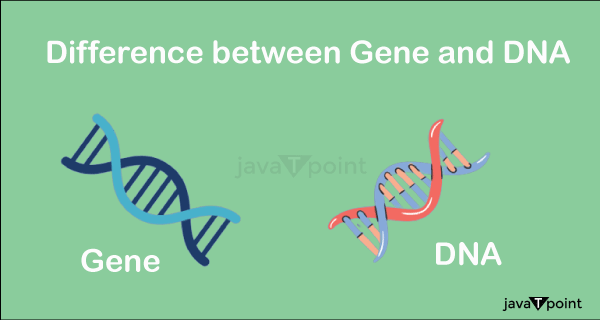Difference between Genes and DNAGenesGenes are units of heredity that are passed down from one generation to the next and are responsible for determining some of the traits of the progeny. Danish botanist Wilhelm Johnson first used the word "gene" in 1909. Genes are inherited as separate units and come in pairs, according to Gregor Mendel's discovery. Chromosomes are teeny-tiny objects that contain genes. Within each of our body's cells are chromosomes. Genes play a significant part in determining physical characteristics. Genes carry information such as whether a person has straight or curly hair, short legs, or long legs. The majority of these are passed down from parents to their children. 
Working of GenesChromosomes are found in sets of two or in matched pairs. Just one chromosome has hundreds, and even thousands, of genes. Deoxyribonucleic acid (DNA) makes up the chromosomes and genes. By way of DNA, certain instructions are written. DNA only serves as a recipe book for the cellular creation of proteins. The majority of the components in our bodies, including bones, teeth, hair, earlobes, blood, and muscles, are formed of proteins. As a result, they are regarded as the foundation of the body. Proteins are necessary for our bodies to function effectively, to grow, and to maintain good health. Scientists estimate that each gene produces up to 10 distinct proteins in the body. Up to 300,000 proteins are possible. Example- Neera's mother had one gene for brown hair and one for red hair, which serves as an illustration of how a gene functions. She gave Neera the gene for brown hair. For brown hair, Neera's father has two genes. Neera acquired two brown hair genes, one from each of her parents. Gene ExpressionGene expression is the process through which the data contained in a gene is utilised to create a functioning product, such as a protein. While non-protein-coding genes, like those for tRNA or small nuclear RNA, produce a functional RNA as a byproduct. Transcripted DNA is converted into RNA, which is then translated into proteins. We call this basic dogma. Stages of Gene ExpressionStructural genes are those that produce amino acid sequences. There are two phases in the gene expression process: Transcription Messenger RNA is created during the process of, and the resulting mRNA molecule is then processed by the enzyme RNA polymerase. Translation This process is how mRNA regulates the production of proteins as well as the following post-translational alteration of the protein molecule. Some genes can also result in the production of other RNA types that are involved in transcription. Some of the components found in structural genes are listed below:
DNADNA, also known as deoxyribonucleic acid, is a sophisticated molecule that houses all of the data necessary to develop and maintain an organism. It is a double-helix molecule that contains the genetic code necessary for the development, operation, growth, and reproduction of every known species as well as many viruses. It consists of two different polynucleotides. This polynucleotide forms a double helix by winding around itself. DNA is present in every cell of a living being. The entire set of DNAs required for a multicellular creature is actually present in almost every cell of that organism. Your genome refers to your entire DNA collection. It has 23 chromosomal pairs, 20,000 genes, and 3 billion nucleotides. Since nucleotides make up the DNA molecule. Each nucleotide is composed of a sugar, a phosphate group, and a nitrogen base. Structure of DNAThe double helix shape of DNA, which resembles a twisted ladder, is a common metaphor for the structure. It is a nucleic acid, and all nucleic acids are made up of nucleotides. Each of the units that make up the DNA molecule, known as nucleotides, consists of the three elements sugar, phosphate groups, and nitrogen bases. The majority of a cell's DNA is located in the nucleus, where it creates chromosomes. Chromosome DNA is bound to proteins called histones. DNA is twisted into a helix, which resembles a spiral staircase made of two strands. Adenine (A), thymine (T), guanine (G), and cytosine (C) are the four chemical components that make up DNA. Hydrogen bonds connect the complementary base pairs of guanine, cytosine, adenine, and thymine. The two strands of a DNA helix are held together by hydrogen bonds between complementary nucleotides. Each base has the capacity to form hydrogen bonds with elements like water from the outside. In addition, the phosphate groups on each nucleotide make hydrogen bonds with one another, forming a helical helix out of the two DNA strands. Genes are short DNA strands that hold unique genetic data. The genetic data necessary for inheritance, as well as for instructions and life processes, is encoded in DNA. The instruction is passed vertically from parent to child during gene transfer. Phosphodiester linkages make form the backbones of both DNA and RNA. When two of the phosphoric acid's hydroxyl groups connect with the hydroxyl groups on other molecules to form two ester bonds, the result is a phosphodiester bond. C-O-PO2-O-C. This connection is a component of the "bond." Phosphodiesters are not only found in DNA and RNA, but also in other types of biomolecules, such as acyl carrier proteins. Difference Between Genes and DNADeoxyribonucleic Acid (DNA)
Gene
Next TopicGene Gun Method
|
 For Videos Join Our Youtube Channel: Join Now
For Videos Join Our Youtube Channel: Join Now
Feedback
- Send your Feedback to [email protected]
Help Others, Please Share









